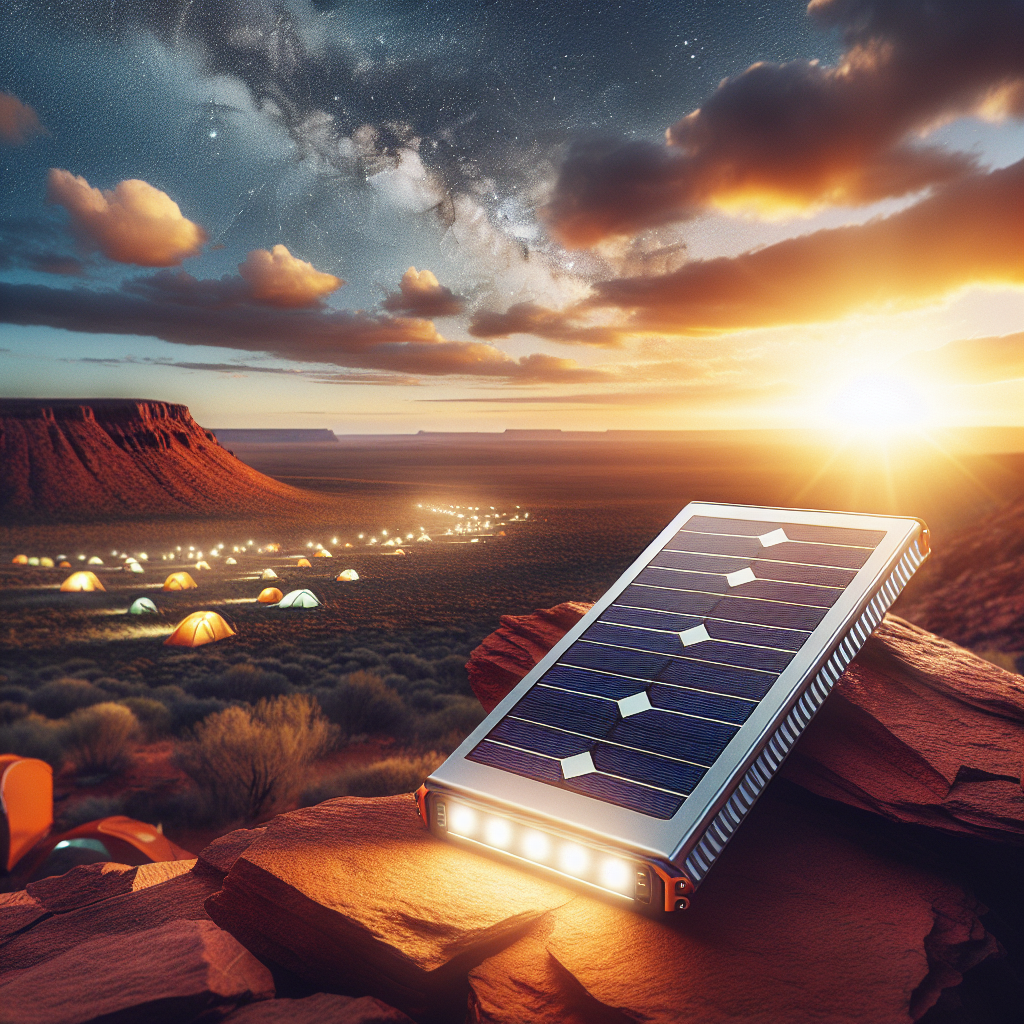

Planning your next camping trip in Australia? Wondering if you can use a portable solar panel to power up your devices while enjoying the great outdoors? Well, you’re in luck! In this article, we’ll be exploring the feasibility of using portable solar panels for camping in Australia. From the sunny beaches to the breathtaking outback, find out how these handy gadgets can make your camping experience not only eco-friendly but also convenient. So, grab your camping gear and let’s dive into the world of portable solar panels in Australia!


Benefits of Using Portable Solar Panels for Camping
When it comes to camping in Australia, using portable solar panels can provide numerous benefits that enhance your overall experience. Not only are these panels an eco-friendly and sustainable energy source, but they also offer freedom from reliance on traditional power sources and can prove to be cost-effective in the long run.
Eco-friendly and sustainable energy source
One of the most significant advantages of using portable solar panels for camping is their eco-friendly nature. By harnessing the power of the sun, you can enjoy your camping trip while minimizing your carbon footprint. Solar energy is a clean and renewable source of power, making it a sustainable choice that contributes towards a healthier planet.
Freedom from reliance on traditional power sources
Camping in remote areas often means being far away from electrical outlets or power grids. However, with the use of portable solar panels, you can break free from this reliance on traditional power sources. Instead of packing heavy batteries or relying on fuel-powered generators, solar panels enable you to generate your own electricity wherever you go. This provides a sense of independence and flexibility during your camping adventures.
Cost-effective in the long run
While the upfront cost of purchasing portable solar panels may seem significant, they prove to be cost-effective in the long run. By utilizing the power of the sun, you can avoid paying for electricity from campsites or resort to purchasing disposable batteries. Once you make the initial investment, solar panels offer free and unlimited energy, reducing your camping expenses in the long term. Additionally, the maintenance cost is minimal, making them a wise investment for avid campers.
Factors to Consider Before Purchasing a Portable Solar Panel
Before purchasing a portable solar panel for camping, it is important to consider several key factors that ensure you make the right choice for your specific needs. By evaluating power output and capacity, portability and weight, durability and weather resistance, charging options and compatibility, and additional features and accessories, you can make an informed decision.
Power output and capacity
When selecting a portable solar panel, it is crucial to consider its power output and capacity. The power output determines the amount of electricity the panel can generate, while the capacity refers to the energy it can store for later use. It is essential to assess your camping power needs and choose a solar panel that can meet those requirements efficiently.
Portability and weight
Since portability is a key factor in camping, it is essential to choose a portable solar panel that is lightweight and easy to transport. You’ll want a panel that can fold or roll up compactly, allowing it to fit into your backpack or camping gear without adding excessive weight.
Durability and weather resistance
Camping often exposes your equipment to various weather conditions, so it is vital to select a solar panel that is durable and weather-resistant. Look for panels made with high-quality and rugged materials that can withstand rain, dust, and extreme temperatures. This ensures the longevity of your solar panel and allows for worry-free camping in different environments.
Charging options and compatibility
Consider the charging options and compatibility of the portable solar panel with your camping devices. Ensure that it is compatible with the batteries, devices, or power banks you intend to charge. Some solar panels have built-in USB ports or adapters that make charging multiple devices simultaneously more convenient. Additionally, panels with integrated charge controllers provide protection and prevent overcharging or damage to your devices.
Additional features and accessories
Some portable solar panels come with additional features and accessories that can enhance your camping experience. These may include built-in LED lights, USB charging ports, or even Bluetooth connectivity for monitoring power usage. Consider these features based on your specific needs and preferences to maximize the functionality of your solar panel.
Choosing the Right Type of Portable Solar Panel
There are several types of portable solar panels available on the market. Understanding the differences between them can assist you in choosing the right one for your camping adventures.
Monocrystalline Solar Panels
Monocrystalline solar panels are known for their high efficiency and sleek appearance. These panels are made from a single crystal structure, allowing for greater electron flow and improved power generation. While they tend to be more expensive, monocrystalline panels are ideal for campers who prioritize space efficiency and maximum power output.
Polycrystalline Solar Panels
Polycrystalline solar panels are cost-effective and offer good overall performance. These panels consist of multiple smaller crystals, making them less efficient than monocrystalline panels. However, they are still a reliable option for camping, especially for campers on a budget.
Thin-Film Solar Panels
Thin-film solar panels are flexible and lightweight, making them highly portable. They are made by depositing thin layers of photovoltaic material onto a substrate such as plastic or metal. While they are less efficient compared to crystalline panels, thin-film panels are suitable for campers who prioritize flexibility and ease of transportation.
Foldable Solar Panels
Foldable solar panels are designed to be compact and easily folded for convenient storage and transportation. These panels typically consist of multiple hinged sections and can be unfolded to expose a larger surface area for solar power production. Foldable panels are a popular choice among campers due to their portability and versatility.
Briefcase Solar Panels
Briefcase solar panels are designed to resemble a small briefcase when folded, making them easy to carry. When unfolded, they reveal two or more panels that can generate significant power. Briefcase solar panels are convenient for campers who require a quick and easy setup.
Rollable Solar Panels
Rollable solar panels are made with flexible materials that can be rolled up for compact storage. They are lightweight and take up minimal space, making them an excellent choice for campers with limited storage capacity. Rollable panels are also versatile and can be attached to backpacks or other camping gear for on-the-go charging.
Determining the Ideal Size of Portable Solar Panel
To determine the ideal size of a portable solar panel for your camping needs, it is necessary to consider your energy requirements, sun exposure, and location. By balancing power needs with portability, you can find the right size that meets your energy demands without compromising convenience.
Calculating energy requirements
Evaluate the energy needs of your camping activities, including charging devices, using lights, or running appliances. Consider the power consumption of each device and the desired duration of use. This will give you an estimate of the energy requirements per day, allowing you to choose the appropriate size of the solar panel.
Consideration of sun exposure and location
The amount of sun exposure your campsite receives plays a crucial role in determining the size of the solar panel needed. Consider the average sunlight hours per day and any potential shading from surrounding trees or structures. It may be necessary to adjust the size of the solar panel accordingly to compensate for reduced sunlight.
Balancing power needs with portability
While it is essential to have a solar panel that can meet your power needs, it is equally important to consider its portability. If you plan on backpacking or hiking to your campsite, a smaller and more lightweight panel may be more suitable. However, if you have ample space in your vehicle or are camping in a stationary location, you may opt for a larger panel that can generate more electricity.


Setting Up and Using Portable Solar Panels
To make the most of your portable solar panels during camping, proper setup and proper usage are key. By following these steps, you can ensure optimal performance and maximize energy generation.
Selecting a suitable campsite
Choose a campsite that offers maximum sun exposure throughout the day. Open areas without obstructions such as trees or tall structures will allow your solar panel to capture ample sunlight. Prioritize a location that provides a clear path for sunlight, especially during the peak hours of solar energy production.
Determining the solar panel angle and orientation
To maximize energy production, it is important to adjust the angle and orientation of your solar panel correctly. In Australia, the ideal tilt angle is typically equal to the latitude of your campsite. However, you may need to adjust this based on the season and specific location. Additionally, ensure that the solar panel is facing true south (for the Northern Hemisphere) or true north (for the Southern Hemisphere) to capture the most sunlight.
Connecting and setting up the solar panel
Once you have determined the location and angle, it is time to connect and set up your portable solar panel. Most panels come with built-in kickstands or brackets that allow for easy mounting on the ground or other surfaces. Ensure that the solar panel is securely positioned and connected to any necessary batteries or devices.
Monitoring and maintaining the solar panel
While portable solar panels require minimal maintenance, it is important to monitor their performance and cleanliness regularly. Keep an eye on the charging status of your devices and the battery levels to ensure efficient power supply. Additionally, regularly clean the solar panel to remove any dirt, dust, or debris that may obstruct sunlight absorption. A gentle wipe with a clean cloth should be sufficient to keep your solar panel in optimal condition.
Common Mistakes to Avoid when Using Portable Solar Panels
To ensure a smooth camping experience with portable solar panels, it is important to avoid common mistakes that can hinder their effectiveness. By being aware of these mistakes, you can take proactive measures to maximize the efficiency and reliability of your solar panel setup.
Insufficient sunlight exposure
Insufficient sunlight exposure can severely impact the performance of portable solar panels. Ensure that the panel is placed in an area with uninterrupted sunlight throughout the day. Avoid shading from trees, tents, or other objects that can cast shadows and reduce sunlight absorption.
Improper positioning of solar panels
Proper positioning is crucial for optimal energy generation. Ensure that the solar panel is correctly angled and oriented to capture the maximum amount of sunlight. Regularly assess the placement to account for any changes in the sun’s position throughout the day.
Inadequate battery capacity
Using a solar panel with an inadequate battery capacity can limit your ability to store and use generated power. Assess your energy requirements and choose a battery that can comfortably accommodate your needs. Consider the number of devices you plan to charge and the duration of use to determine the appropriate battery capacity.
Not monitoring power usage
Failing to monitor power usage can lead to unexpected battery drain and reduce the effectiveness of your solar panel setup. Be mindful of the power consumption of your devices and adjust usage as necessary. Utilize energy-saving features whenever possible to prolong the battery life and maximize energy efficiency.
Neglecting to clean and maintain the solar panel
Regularly cleaning and maintaining the solar panel is essential for optimal performance. Neglected panels covered in dirt, dust, or debris can experience reduced sunlight absorption and power generation. Take the time to clean the panel, especially after camping trips in dusty or dirty environments, to ensure optimal energy production.


Understanding Solar Panel Regulations in Australia
When using portable solar panels for camping in Australia, it is important to adhere to the relevant regulations and guidelines. This ensures compliance with safety standards and minimizes any potential risks.
Compliance with Australian standards and regulations
Portable solar panels used for camping in Australia must comply with the relevant Australian standards and regulations. Ensure that the panel you purchase meets the safety requirements and has been tested and certified accordingly. This ensures that the panel is safe to use and will not pose any electrical or fire hazards.
Obtaining necessary permits and approvals
Depending on the location and specific camping regulations, you may require permits or approvals to install and use portable solar panels. Some camping areas may have specific rules regarding the use of solar panels, and it is important to familiarize yourself with these regulations. Check with the local authorities or park management to obtain any necessary permits or approvals before setting up your solar panel.
Responsibility for fire safety and electrical safety
When using portable solar panels, it is essential to prioritize fire safety and electrical safety. Ensure that the panel is set up in a safe manner, away from any flammable materials or potential fire hazards. Take precautions to prevent electrical shocks or hazards by following proper installation and usage guidelines. Familiarize yourself with emergency procedures and guidelines to address any potential safety incidents.
Best Practices for Camping with Portable Solar Panels
To make the most of your camping experience with portable solar panels, consider implementing these best practices. These practices will help you conserve energy, optimize efficiency, and ensure a smooth and enjoyable camping trip.
Plan and conserve energy usage
Plan your energy usage and conserve power whenever possible. Prioritize essential devices and turn off or minimize the use of non-essential electronics. Opt for energy-efficient appliances and gadgets that consume less power without compromising functionality.
Utilize energy-efficient camping equipment
Invest in energy-efficient camping equipment to further minimize power consumption. LED lights, energy-efficient stoves, and low-power fans are examples of gear that can significantly reduce energy usage. By choosing these eco-friendly options, you can prolong the battery life of your portable solar panel.
Optimize charging during sunlight hours
Take advantage of the sunlight hours to optimize charging. Charge your devices during the day when the solar panel is generating the most power. This maximizes energy utilization and allows for sufficient recharging of batteries and devices.
Properly store and transport the solar panel
Ensure the proper storage and transportation of your portable solar panel to prevent damage. Fold or roll up the panel according to the manufacturer’s instructions for compact storage. Consider using a protective case or bag to shield the panel from potential impacts or scratches. Properly storing and transporting the panel will prolong its lifespan and maintain its efficiency.


Popular and Reliable Brands of Portable Solar Panels
When purchasing a portable solar panel for camping, it is advisable to choose from reputable and reliable brands. Here are a few popular brands known for their quality and performance:
Goal Zero
Goal Zero is a well-known brand in the portable solar industry, offering a wide range of reliable and efficient solar panels. Their products are designed to be rugged and durable, making them suitable for camping in various conditions. Goal Zero also provides integrated battery systems and accessories to enhance the usability of their solar panels.
Renogy
Renogy is another trusted brand that offers an extensive selection of portable solar panels for camping. Renogy’s products are known for their high efficiency and durability, capable of generating ample power in outdoor settings. Their diverse range of solar panels caters to different camping needs, ensuring there is an option suitable for every camper.
Jackery
Jackery specializes in portable power solutions, including solar panels for camping. They offer compact and lightweight solar panels that are easy to set up and transport. Jackery’s panels are known for their efficiency and reliability, providing campers with a convenient and sustainable power source.
Energizer
Energizer, a renowned brand in the battery industry, also offers portable solar panels for camping. Their solar panels are designed to be highly durable and weather-resistant, ensuring long-lasting performance in outdoor environments. Energizer’s panels are suitable for both casual campers and outdoor enthusiasts who require a reliable power source.
Anker
Anker is a trusted brand known for its high-quality electronic accessories, including portable solar panels. Anker’s solar panels are compact, lightweight, and efficient, making them ideal for camping trips. They offer a range of features such as foldability, multiple charging ports, and compatibility with various devices.
ECEEN
ECEEN specializes in portable solar products that cater specifically to outdoor activities. Their solar panels are designed for rugged environments, offering durability and resistance to harsh weather conditions. ECEEN’s panels are lightweight, foldable, and easy to use, making them a popular choice for campers seeking reliable portable power.
Conclusion
Using portable solar panels for camping in Australia provides numerous benefits, including eco-friendliness, freedom from reliance on traditional power sources, and long-term cost-effectiveness. By considering factors such as power output, portability, durability, charging options, and additional features, you can choose the right solar panel for your needs. Evaluating different types of panels and determining the ideal size allows you to optimize energy generation while balancing portability. Proper setup, usage, and maintenance of portable solar panels contribute to their efficiency and performance. Avoiding common mistakes and adhering to regulations ensures a safe and hassle-free camping experience. Implementing best practices, such as conserving energy usage and utilizing energy-efficient equipment, further enhances the benefits of camping with portable solar panels. Lastly, choosing reliable brands like Goal Zero, Renogy, and Jackery ensures quality and reliability. With the right portable solar panel, you can enjoy a sustainable and empowered camping adventure in Australia.


Leave a Reply